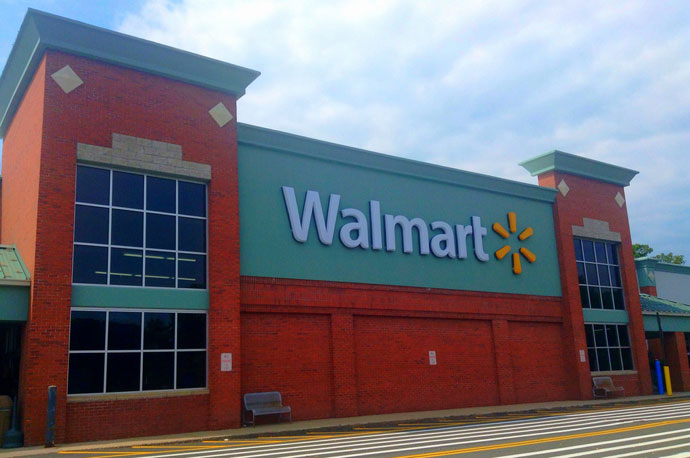Stores Woo Customers By Going Green: Does It Work?

Image via Flickr/ Mike Mozart
If you’ve seen a commercial for Target or been in a Walmart during the last several months, you probably already know that both stores are making a big push to become more eco-friendly. The Target Sustainable Product Standard, introduced in 2013, establishes standards for what makes something truly sustainable; Walmart is developing a sustainability index for its products; several new organic and sustainable initiatives are launching at Target this year; Walmart is committed to reducing its greenhouse gas emissions; Target stores offer discounts on reusable bags; the list goes on and on to the point of, dare I say it, competition. But what is this new trend really doing for retailers?
According to the New York Times, the organic food and products industry is booming — it grew to $31.5 billion in sales in the U.S. in 2012, as opposed to $8.4 billion a decade earlier. Natural and organic products had sales growth in the double digits during 2012. These products are super trendy, as evidenced by the fact that you can now buy things like frozen edamame and organic tea tree oil at basically any store you walk into. No longer do employees look at customers like they’re insane when they ask for chia seeds.
Target is widely publicizing its associated with actress Jessica Alba, who created The Honest Company. Consisting of eco-friendly, non-toxic products like dish soap, laundry detergent, conditioner, sunscreen, and more, The Honest Company hit Target stores in June. Then there’s Target’s Simply Balanced store brand, which, Target claims, includes more than 40 percent organic products.
“Almost all of our guests, 97 percent, say they buy some product that is natural, organic or sustainable,” Kathryn A. Tesija, Target’s executive vice president for merchandising and supply chain, told the New York Times. Naturally, Target wants to capitalize on this by winning the loyalty of its eco-friendly customers.
But has this resulted in bigger profits? Unfortunately for Target, its profits were affected by last year’s customer data breach. In fact, the Motley Fool suggests that Target has been alienating its customers more and more with its mismanagement of the data leak and its aggressive REDcard marketing campaign. CNN also flirts with the idea that Target was “having trouble connecting” with customers before the data breach debacle… and afterward, profits dropped massively. The leak cost Target $111 million in the second quarter of 2014, says CNN, and its profit forecast for this year has dropped yet again — not overly surprising, since most people don’t enjoy having their private information stolen and their bank accounts compromised.
However, TheStreet’s Ratings Team predicts that Target’s declining pattern of earnings will reverse over the coming year. And according to Target’s own corporate overview, total sales for 2012 increased by 5.1 percent — a trend that might perhaps have continued if the data breach hadn’t happened.
Tech Times also notes that since consumers are becoming more environmentally aware, they will most likely shop in stores that hold the same values as them. So for Target, embracing the environment might result in a healthier revenue stream by slowly undoing the damage of the data breach and wooing its customers in what the chain probably hopes is a totally non-alienating way.
“We’ve got to major in these signature categories and make some bold changes to re-energize those businesses,” Target Chief Executive Brian Cornell told the Wall Street Journal recently.
Walmart, however, is a different story. Walmart is what some people might call a massive, slobbering behemoth — it had fiscal year 2013 sales of about $466 billion and 2012 sales of $469.2 billion. (In comparison, Target had 2012 sales of $73.3 billion.) Walmart is projected to make even more during 2014, and like Target, it has been phasing in greener products over the last several years, including its Great Value Naturals line. But whereas Target seems to be pinning its hopes on recapturing customers’ love with green products, Walmart’s efforts toward sustainability appear to be more half-hearted.
Although the retailer has three lofty sustainability goals — to create zero waste, to be supplied by 100 percent renewable energy, and to sell products that “sustain people and the environment” — not all of them have been met. Last year, an environmental group found that Walmart’s greenhouse gas emissions had continued to grow since 2005, and in an interview with the Wall Street Journal in April, Walmart Chairman Michael T. Duke said, “There’s nowhere in our strategy that says we want to shrink the company. We still want to keep growing. But we’ve established a goal to reduce energy consumption.”
The total square footage of Walmart stores increased 40 percent for 2005 to 2011, according to the Huffington Post, which also cited a report that says Walmart’s emissions were high enough to make it one of the biggest polluters of 2013. As of 2012, the retail chain was only 4 percent of the way toward getting all of its energy from renewable resources. Last year, a group of environmental organizations like the Sierra Club and Greenpeace wrote a letter to Walmart that stated, “Eight years have passed and Walmart has failed to fulfill its promise… It’s time for Walmart to do more than just flashy environmental PR.”
But Walmart continues to grow even with all these questions swirling around, leading to the conclusion that Walmart is just going to grow in a Hulk-like fashion no matter what. Whether its green initiatives are making progress or not, Walmart is still more than healthy.
Product sales research firm SPINS, however, notes that a majority of households bough natural and organic in 2012, and that shoppers within “all types of retailer stores” increased their spending on these kinds of products.
So is green good for the bottom line? Basically, it looks like green products are selling no matter where they are — it’s up to stores to capitalize on their popularity.









































